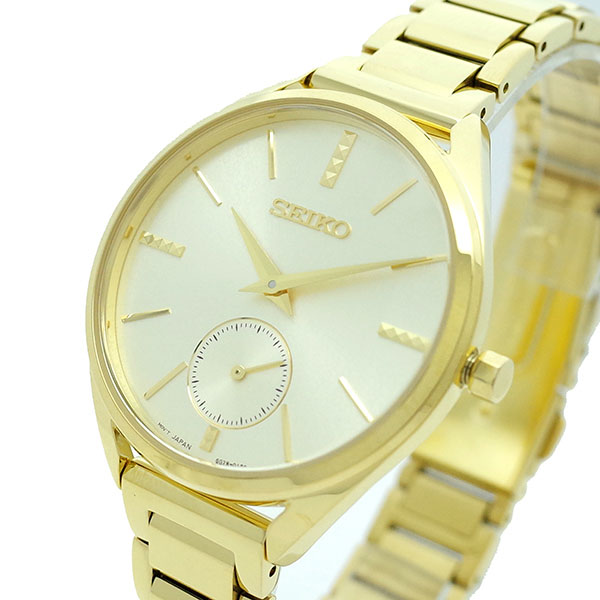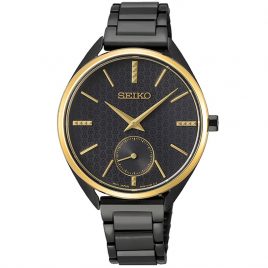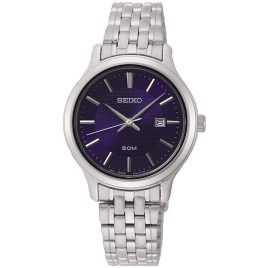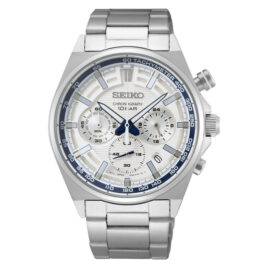Description
SEIKO QUARTZ Conceptual SRKZ50P1 Specifications :
| Feature |
| ||
|---|---|---|---|
| Driving system | Quartz | ||
| Caliber Number | 6G28 | ||
| Case material | Stainless steel | ||
| Case back | Solid | ||
| Band type | Bracelet | ||
| Band material | Stainless steel | ||
| Band color | Gold tone | ||
| Band width | 15mm | ||
| Clasp | Fold over with double push button | ||
| Dial color | Gold tone | ||
| Glass material | Hardlex crystal | ||
| Hands | Gold tone (hour, minute) | ||
| Dial markers | Gold tone index | ||
| Sub dials | One – small seconds | ||
| Bezel | Fixed gold tone | ||
| Crown | Pull / push | ||
| Calendar | Date display at the 3 o’clock position | ||
| Function | Hour, minute, second | ||
| Features | Included in the collection is one special edition for the 50th anniversary of the first quartz watch in 1969 Gold accents and quartz watch 50th anniversary special engraving on case back | ||
| Water resistance | 5 bar water resistance (50 meters / 165 feet) | ||
| Size | D35mm x H9mm | ||
| Weight | 74g |

50th Anniversary Quartz Special Editions
The Essentials. Timekeeping that meets – and sets – the standard for reliability.
Fifty years ago, Seiko revolutionized watchmaking with the first commercially available quartz watch, the Astron, introduced on December 25, 1969. Ten years in the making, and utilizing a host of proprietary technologies, this landmark innovation provided unprecedented accuracy and convenience, changing the concept of timekeeping precision forever. Today, this milestone is being celebrated by including Special Edition designs, each with commemorative case back and quartz symbol pattern dial, as the centerpiece of the Essential Collection, featuring quartz and solar movements to wear with confidence.
SEIKO QUARTZ Conceptual SRKZ50P1 Features :
- Gold tone stainless steel case
- Gold tone stainless steel bracelet
- Fixed gold tone stainless steel bezel
- Solid case back
SEIKO QUARTZ Conceptual SRKZ50P1 History :
The company was founded in 1881, when Kintarō Hattori opened a watch and jewelry shop called “K. Hattori” (服部時計店 Hattori Tokeiten) in the Ginza area of Tokyo, Japan. Eleven years later, in 1892, he began to produce clocks under the name Seikosha (精工舎 Seikōsha), meaning roughly “House of Exquisite Workmanship”. According to Seiko’s official company history, titled “A Journey In Time: The Remarkable Story of Seiko” (2003), Seiko is a Japanese word meaning “exquisite” or “success” (“exquisite” is usually written 精巧 from Chinese jīngqiǎo, while the meaning “success” is usually written 成功 from Chinese chénggōng).
The first watches produced under the Seiko brand appeared in 1924. In 1969, Seiko introduced the Astron, the world’s first production quartz watch; when it was introduced, it cost the same as a medium-sized car. Seiko later went on to introduce the first quartz chronograph.
In the late 1980s, Seiko produced the first automatic quartz that combined the self-energizing attributes of an automatic watch with quartz accuracy. The watch is entirely powered by its movement in everyday wear. In 1991, to increase popularity, these watches were relaunched under the name Seiko Kinetic.
source : https://en.wikipedia.org/wiki/Seiko

















